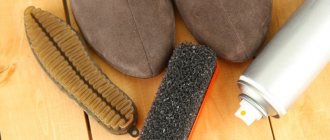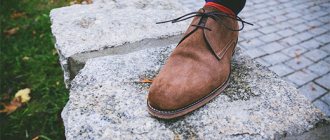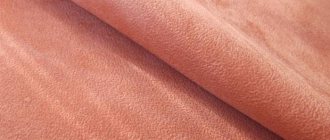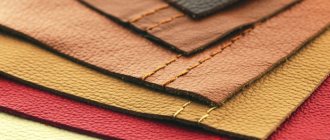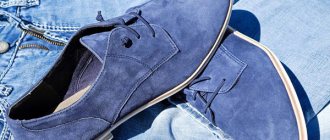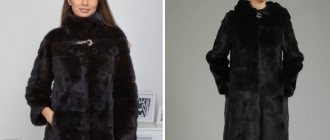Suede is a delicate and capricious material that does not lose popularity. Suede items look elegant, stylish and aesthetically pleasing. They are practical, comfortable and easy to wear. Soft, flexible and elastic, suede stretches and molds easily to the shape of your foot or body, allowing your skin to breathe and retaining warmth.
Unfortunately, under the guise of natural suede they sell cheap, less durable, practical artificial material. At the same time, due to modern processing and equipment, synthetics today differ little from the original in appearance, and at the same time they cost less.
However, it will last much less. In addition, artificial suede, unlike natural one, freezes, allows moisture to pass through, but does not allow air to pass through. Therefore, it is important to distinguish the original from the fake. In this article we will look at how to distinguish natural suede from artificial one.
Specifics and properties of natural suede
Suede is a type of genuine leather produced by fat tanning. There are two types of material. To obtain an unrefined variety, the skins of sheep and calves are used. Such skin is dense, but it is difficult to withstand mechanical stress.
The refined variety of suede is more in demand due to its softness and fineness. It breathes and is characterized by comfortable use. This material is obtained from the skins of goats and deer. In addition, vegetable fats are used in the production of the product, including flax oil, bone or fish oil.
To obtain natural suede, wool is removed from the skin, the remainder is greased and processed. When the fat is completely absorbed and becomes one with the protein of the skin, the material is painted and, if necessary, decorated. The result is high-quality natural suede with light fleecy, which is resistant to moisture and wear.
Despite its resistance to moisture and wear, the material requires careful care and use. Suede does not tolerate large amounts of moisture, so do not wear suede items in the rain. Do not dry products on a radiator or using electrical appliances; use special impregnations and sprays. How to care for suede items and renew suede, see here.
Qualities of natural suede
Natural suede is leather tanned in a special way. It is made mainly from the skins of large wild horned animals. After obtaining the raw materials, an expensive manufacturing process follows. Therefore, genuine suede has a high price. However, you can also put a high price on a fake; do not be guided only by this indicator.
On a note! An artificial substitute can also have a high price; this indicator is not reliable.
Natural suede has the following qualities:
- thin, but very durable;
- “breathes” well;
- the material is soft and porous;
- does not have a reverse side - the same appearance on both sides.
It feels very durable and somewhat similar to rubber, as it is very elastic, but does not have much stretch.
Characteristics of artificial suede
Artificial suede is used to create budget and affordable shoes, clothing and accessories. The material is produced by two methods. In the first case, split microfiber threads are used, which make the product fleecy. The fabric is soft and pleasant to the touch.
In the second method, a polymer coating is applied to the fabric base and polished with a special laser. The result is an aesthetic and comfortable material, which is finally coated with a beautiful coating. However, artificial suede is not resistant to wear and abrasion, moisture and water, temperature changes, frost and heat. It does not allow air to pass through, which causes discomfort when using shoes and clothing.
Due to modern technologies and the processing of synthetic materials, it is becoming more difficult to distinguish between natural and artificial suede. In addition, the products are similar in appearance. We offer some tips to help you determine whether it is natural suede or not.
Details
Artificial suede, what kind of material is it - characteristics
This type of suede is used to make affordable and budget clothing, shoes, and accessories. The material is made in two ways. The first method uses split microfiber threads, which make the item fleecy. The material becomes soft and pleasant to the touch.
In the second method, a polymer coating is applied to a fabric base, which is then polished with a special laser. The result is a comfortable and aesthetic material, which is then covered with a beautiful coating. But artificial suede is not resistant to abrasion and wear, temperature changes, water and humidity, heat and frost. In addition, it does not allow air to pass through, which makes wearing things from it uncomfortable.
REFERENCE! Today, it is becoming increasingly difficult to distinguish natural suede from artificial one, due to modern technologies and processing options for synthetic materials.
Externally, the products are very similar to each other. There are several tips on how to determine the naturalness of suede.
How to distinguish natural suede from artificial one
- Natural material will not look flawless and perfect. There will always be pores on the surface of suede; it will not be smooth. Small scratches and creases are even allowed on the surface.
- Try running your hand over the product. The suede should change texture and color, and the pile should bend. The artificial material will retain its structure and shade.
REFERENCE! In addition, natural pile can be combed and laid in any direction.
- The pile of natural suede is soft, velvety and delicate. Artificial pile has a slight roughness.
- Natural suede inside should be as pleasant and soft as outside. On the reverse side, the suede should look like velvet paper.
- To check, apply a couple of drops of water to the surface. Natural suede should absorb water and remain slightly damp in this area. Drops from synthetics will roll off without a trace or remain on the surface unabsorbed.
- Place your palm on the product. Natural suede should immediately warm up, while artificial suede should remain cold.
- Real suede products always have a sample tag with a small piece of suede. It can be used to safely conduct various experiments and actions to verify the authenticity of a product.
- Natural suede has a specific, but not very pronounced leather smell. Synthetics often smell like that or don’t smell like anything at all.
When choosing a product, you need to understand that fake suede delaminates, but real suede does not. To check, inspect the raw edge of the leather inside the product. On its cut, if the material is artificial, a thin layer of fabric to which polymer fibers are attached will become visible. The cut of natural suede will be solid.
- The suede item needs to be slightly bent. A small crease should form on its surface, but after a few minutes it should return to its original form.
- Real suede does not have a uniform shade over the entire surface. In the production of natural and high-quality products, only real dyes containing plant elements are used.
REFERENCE! The item should be slightly different in shades.
- The product must be held in your hands. If this leaves fingerprints on the surface of the pile, then it is synthetic, velor or nubuck.
- It is also necessary to inspect the product from the reverse side. There should be no folds on it. The edges of real suede are treated in a special way.
- The pile of natural suede products is low and fine, shiny and not loose, without streaks, stains or marks, and without roughness or abrasions. However, their cost is always higher.
Differences from nubuck and velor
Pay special attention to nubuck and velor. These are more affordable materials that are similar in appearance to natural suede. But the latter is flexible, elastic and soft. And the original retains these qualities even after getting wet and drying.
Velor and nubuck become hard and unpleasant to the touch. When wet and after drying, the fibers of such materials stick together, and the products lose their aesthetics and attractiveness. Traces and imprints remain on the surface, and creases in the pile form in different directions. Shoes made of velor or nubuck dissolve faster and last much less.
Velor is a dense and soft material with a velvety and fleecy surface. Unlike suede, it deforms when interacting with moisture and detergents. Velor is used for upholstery of upholstered furniture, tailoring, curtains and accessories, for the manufacture of car and furniture covers.
Velor has pile on only one side, while suede has pile on both. It has a solid color and fingerprints remain on the surface. The long and thick pile of velor easily changes directions, and the material itself does not bend and is cheaper. In addition, it wears out quickly and attracts dust, threads and hair. And creases easily form on the surface.
Nubuck is a thin and viscous material that, in a fairly short period of time, loses its physical properties, shape and presentable appearance. It is smoother and cheaper than velor and suede. Nubuck is used to make shoes and bags, various accessories, outerwear, and sometimes furniture.
Nubuck gradually wears out and becomes dull, and wear marks, stripes and cracks form on the surface. The life of such products can be extended with proper care and careful use. How to care for nubuck items at home, see the link.
Features of the material
- Natural suede is made from the skin of animals: from goats and deer to calves and sheep. It is important to know that natural suede has a slight hairiness, unlike artificial materials and velor. To figure out whether the suede you have in front of you is natural or artificial, you should understand the production technology of the fabric: animal skin is impregnated with fats. In such products the skin breathes.
- Artificial suede is a fabric made from microfiber threads. If the fabric is made using a non-woven method, then a polymer composition is applied to the fabric, which is then processed using a laser.
What is the difference between nubuck and suede?
Nubuck is actually a type of suede, and both are typically made from leather such as calfskin, although they can also be made from sheep, cow, goat, or deer hide. At first glance, they look the same, but are actually created and processed differently, as noted earlier. Nubuck and suede differ from each other in that nubuck is created from the full-grain side of the hide, which is the outer part, while suede is created from the bottom part of the leather. Both of these leathers are created by sanding.
Because of this difference, there is a wide price range between nubuck and suede, with suede being the cheapest. Nubuck is made from the highest quality sanded leather used to make high quality leather products.
What is the difference between nubuck and suede:
- Nubuck has a velvety texture due to polishing, which creates a soft surface. Down are short protein fibers on the surface of the skin that help create a velvety surface.
- It is stronger and more durable, and more resistant to damage and wear than suede.
- It also has a genuine leather marking, giving it a rougher appearance than suede.
- Stronger and thicker than suede. It is usually more expensive than suede. For example, nubuck resists water damage because water simply darkens its surface temporarily and then dries without causing any long-term damage. Although its appearance is more similar to suede, nubuck has more similarities to aniline leather.
- Nubuck scratches easily. This is a vulnerable skin as it cannot use any type of protective coating.
Suede is much softer than nubuck because it is made from the inside of the leather, which is in contact with the flesh of the animal. It is sanded and polished to remove all impurities.
- Suede is more flexible than nubuck. It's much more subtle.
- Suede is a good material for lining shoes, but it is not as durable as nubuck.
- It can also be painted easily because it has a more porous surface and it is recommended to apply a protectant to the surface.
Leatherworkers must often apply dye or color to disguise the embossing and sanding techniques they use to finish nubuck leather, although sometimes the finished leather is white.
When caring for suede or nubuck, it is important to choose the right brush for each material. Since nubuck is a harder material than suede, if a nubuck brush is used on suede, it will damage the down. On the other hand, a suede brush used on nubuck will be virtually ineffective.
Many people find that suede shoes are harder to maintain and more expensive than their shiny leather counterparts. This is far from the truth. Suede and nubuck actually require less maintenance. These boots don't need polishing and don't need to be polished at all, so say goodbye to weekly shoe polishing.
© 2021 textiletrend.ru
Basic rules on how to distinguish natural material from artificial
To check the naturalness of the material, you can conduct several tests. They are quite simple and can be made right at the point of purchase.
- Take the product in your hands. Whether it's shoes or other products, touch the surface with your palm. The natural base is cold, but it will quickly warm up from the warmth of your hand, the artificial one will be warm initially and will not change the temperature.
- Press your fingers into the surface. On a substitute, fingerprints are more visible and will remain for a longer time.
- Apply a small drop of water. A natural base will quickly absorb moisture; with an artificial one, it will simply slide off.
On a note! The best way to determine naturalness is by touch.
To the touch, natural suede is elastic, cold, soft, somewhat reminiscent of rubberized leather, the pile is very short, so the surface is almost smooth.


